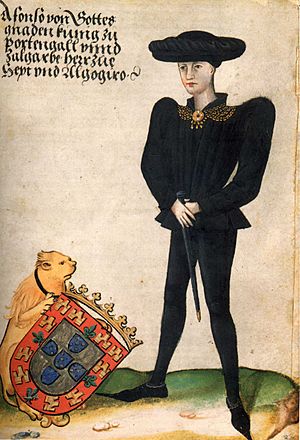Battle of Guinea facts for kids
Quick facts for kids Battle of Guinea |
|||||||
|---|---|---|---|---|---|---|---|
| Part of War of the Castilian Succession | |||||||
 16th century map of the Portuguese possessions in western Africa |
|||||||
|
|||||||
| Belligerents | |||||||
| Commanders and leaders | |||||||
| Jorge Correia Mem Palha |
Pedro de Covides (POW) Joanot Boscà (POW) |
||||||
| Strength | |||||||
| 11 ships | 11~35 ships | ||||||
| Casualties and losses | |||||||
| no ships lost |
|
||||||
The Battle of Guinea was a naval battle that happened in 1478. It took place in the Gulf of Guinea, off the coast of western Africa. This battle was fought between a Portuguese fleet and a Castilian fleet. It was part of a larger conflict called the War of the Castilian Succession.
This battle was very important for Portugal. It helped Portugal keep its strong position in the Atlantic Ocean. The battle also led to a very good agreement for Portugal in the Peace of Alcáçovas in 1479. This treaty decided how the Atlantic and disputed lands would be shared. Most areas stayed under Portuguese control, except for the Canary Islands. These included Guinea, Cape Verde, Madeira, and the Azores. Portugal also gained the sole right to conquer the Kingdom of Fez. Plus, Portugal got exclusive rights to all lands discovered or to be discovered south of the Canary Islands.
Why the Battle Happened
In 1478, Prince John of Portugal was in charge of Portugal's sea explorations. He learned that a large Castilian fleet had sailed from Seville. This fleet had up to 35 ships and was led by Pedro de Covides. The Castilian rulers, Isabella I of Castile and Ferdinand of Aragon, had sent them. Their goal was to attack the Portuguese at Mina in the Gulf of Guinea. They also wanted to trade with the local people there.
Prince John quickly got a fleet of eleven ships ready. He wanted to stop the Castilian ships. He gave command of the Portuguese fleet to two of his knights, Jorge Correia and Mem Palha.
The Battle Begins
When the Portuguese fleet arrived at the Gulf of Guinea, the Castilians had already been there for about two months. They were busy trading with the African people. They exchanged cheap items like shells, old clothes, and brass bracelets for gold. They were also conducting slave raids along the coast of Guinea.
The Castilian fleet was anchored in a harbor near Mina. The Portuguese fleet launched a surprise attack early in the morning. The Castilians were not ready for this. They were quickly and completely defeated. They had to surrender to the Portuguese. The Portuguese captured the entire Castilian fleet. They also took a huge amount of gold. The Portuguese suffered very little harm themselves.
What Happened After
The captured Castilian fleet was taken to Lisbon. The large amount of gold that Portugal captured was very useful. It helped King Afonso V pay for his military campaign in Castile.
After the war ended, the Portuguese exchanged the Castilian prisoners they had captured. They traded them for Portuguese prisoners taken during the Battle of Toro.
The next year, the Treaty of Alcáçovas was signed. This agreement was between Portugal and Castile. In the treaty, King Afonso V of Portugal gave up his claim to the Castilian throne. He recognized Isabella and Ferdinand as the rulers of Castile. He also gave up his claim to the Canary Islands. In return, Queen Isabella I of Castile recognized Portugal's strong position in the Atlantic Ocean. She confirmed that Madeira, the Azores, and the Cape Verde Islands belonged to Portugal. The treaty also stated that Portugal had rights to:
- "...lands discovered and to be discovered, found and to be found... and all the islands already discovered and to be discovered, and any other island which might be found and conquered from the Canary Islands beyond toward Guinea..."
More to Explore
- History of Portugal
- Portuguese Empire
- House of Avis
- Henry the Navigator
- Age of Discovery
- Treaty of Tordesillas
- Elmina Castle
 In Spanish: Batalla naval de Guinea para niños
In Spanish: Batalla naval de Guinea para niños


